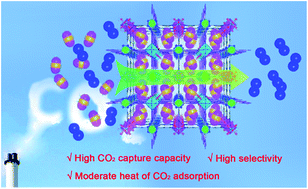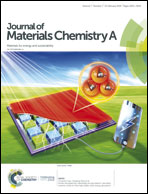A metal–organic framework with suitable pore size and dual functionalities for highly efficient post-combustion CO2 capture†
Abstract
Capturing carbon dioxide (CO2) from flue gases with porous materials has been considered as a viable alternative technology to replace traditional liquid amine adsorbents. A large number of microporous metal–organic frameworks (MOFs) have been developed as CO2-capturing materials. However, it is challenging to target materials with both extremely high CO2 capture capacity and gas selectivity (so-called trade-off) along with moderate regeneration energy. Herein, we developed a novel porous material, [Cu(dpt)2(SiF6)]n (termed as UTSA-120; dpt = 3,6-di(4-pyridyl)-1,2,4,5-tetrazine), which is isoreticular to the net of SIFSIX-2-Cu-i. This material exhibits simultaneously high CO2 capture capacity (3.56 mmol g−1 at 0.15 bar and 296 K) and CO2/N2 selectivity (∼600), both of which are superior to those of SIFSIX-2-Cu-i and most other MOFs reported. Neutron powder diffraction experiments reveal that the exceptional CO2 capture capacity at the low-pressure region and the moderate heat of CO2 adsorption can be attributed to the suitable pore size and dual functionalities (SiF62− and tetrazine), which not only interact with CO2 molecules but also enable the dense packing of CO2 molecules within the framework. Simulated and actual breakthrough experiments demonstrate that UTSA-120a can efficiently capture CO2 gas from the CO2/N2 (15/85, v/v) and CO2/CH4 (50/50) gas mixtures under ambient conditions.

- This article is part of the themed collection: 2019 Journal of Materials Chemistry A Most Popular Articles


 Please wait while we load your content...
Please wait while we load your content...